Leaf Feeders
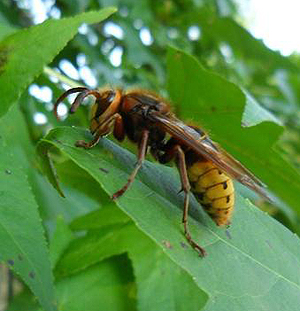
David Stephens, Bugwood.org
Wasps and hornets may chew bark from twigs and branches. Feeding may girdle and kill individual branches.
Sap Feeders
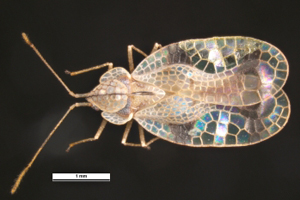
Pest and Diseases Image Library, Bugwood.org
Lace bugs are 1/8 inch to 3/16 inch long sap-feeding insects with clear, ornate, lacy wings; nymphs are spiny and wingless. Lace bugs spend the winter as eggs that hatch in April. Both stages live on the lower surface of leaves. As they feed on plant sap, they leave tiny yellow to white spots on leaves and dark, tarry waste spots on the under sides. Early feeding signs are easy to overlook but as numbers grow, entire leaves may turn gray to white and drop prematurely. There are several generations each year. This insect feeds on over 100 types of Rhododendron, as well as mountain laurel.
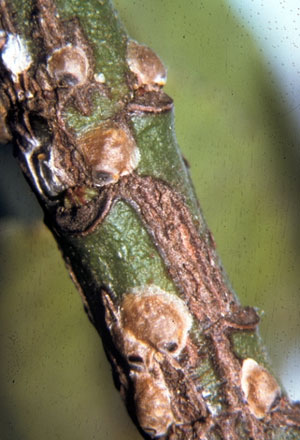
United States National Collection of Scale Insects Photographs,
USDA Agricultural Research Service, Bugwood.org
Greedy scale are small armored scales that create a conical shaped cover. As they grow and shed their old exoskeleton, it is incorporated into the wax that makes up the shield. Eventually this results in a characteristic off-center nipple or dot on the outer coating. There are often concurrent overlapping generations on plants
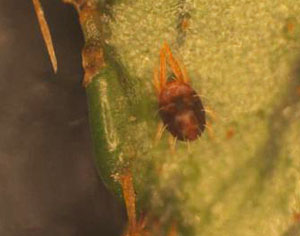
Tracy Wootten, University of Delaware, Bugwood.org
Southern red mites are tiny (1/50 inch) arthropods with a dark red or brown color. They live on the underside of leaves and use needle-like mouthparts to remove the contents of individual cells. This produces tiny white to yellow spots on leaves, sometimes called flecking or bronzing. Infestations are usually most serious during cool periods of spring and fall.
Borers
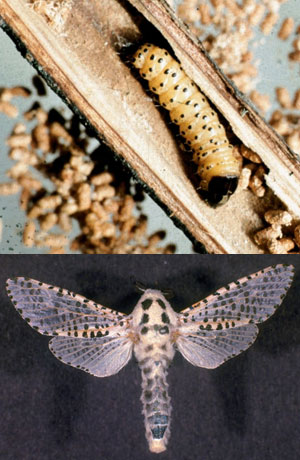
Petr Kapitola, Central Institute for Supervising and Testing in Agriculture,
Bugwood.org (larva);James Solomon, USDA Forest Service, Bugwood.org (adult)
Both the caterpillar and adult of the Wood leopard moth are very distinctive. The caterpillar is the damaging stage, feeding under the bark of host trees. It is a white-orange color with numerous spots on its body. The adult is white with six black dots on the thorax and black markings on the remainder of the body. Adults may be active June-September and larvae feed inside of plants for 2-3 years.
Root Feeders
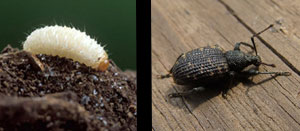
grub: Peggy Greb, USDA Agricultural Research Service, Bugwood.org ;
adult: Cheryl Moorehead, Bugwood.org
Black vine weevil grubs are white legless larvae with yellow brown or red heads that live in the soil and feed on plant roots. Moderate root feeding may cause plants to show signs of drought stress. Girdling can occur and nutrient transmission is disrupted, occasionally leading to death of the plant. The adults (0.5 inch long) are dark snout beetles that may chew crescent-shaped holes in leaves while feeding at night. Normally there is one generation per year with the larva overwintering. Pupation and adult emergence occurs in the spring. Sometimes adults may overwinter which can result in damage occurring from larvae earlier in the season.